Harmonica Holder – A Practical Guide for using the Rack to play Harmonica and Guitar
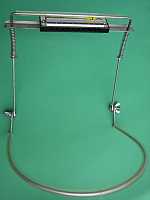 Guitar player/singers often use a harmonica holder or rack. The harmonica holder can be challenging, hence most players use it sparingly.
Guitar player/singers often use a harmonica holder or rack. The harmonica holder can be challenging, hence most players use it sparingly.
Being a harmonica player, I can show how to use the harmonica holder better. I’ll outline how to set it up, then how to play harmonica and guitar together. Those who have never used a harmonica holder may find a new dimension for their act, without much extra work or extra gear to carry.
I’ll assume that you play some guitar and perhaps less harmonica. If you want to learn more about harmonica playing then visit my online lessons.
Choosing a harmonica holder
Most harmonica holders look like the one above. The harmonica is held with a spring loaded clamp, the device slips around your neck. The harmonica is moved up to your mouth, two wing nuts are then tightened to hold it in place. A common problem with harmonica holders is the instrument moving away from your mouth as the wing nuts slip. The more expensive holders have stronger wing nuts, to prevent this happening. The extra money is well spent.
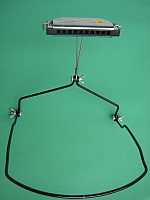 The Dunlop “Harp Handle” shown here has more adjustment options. Three wing nuts are used, providing an extra pivot point. This allows greater control over the harmonica height and angle than the simpler harmonica holders. The clamps fits over the ends of the harmonica.
The Dunlop “Harp Handle” shown here has more adjustment options. Three wing nuts are used, providing an extra pivot point. This allows greater control over the harmonica height and angle than the simpler harmonica holders. The clamps fits over the ends of the harmonica.
Harmonica holders provide “hands free” harmonica playing. The challenge however is keeping good pressure between the harmonica and your mouth without your hands. This pressure is essential for good tone and accurate playing. For this reason I prefer a more robust harmonica holder, where the instrument remains close to your mouth when you press against it. I use the Hohner holder shown above, it is strong and keeps the harmonica where I want it.
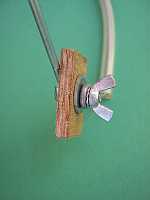 It is crucial that the wing nuts at the joint of the harmonica holder do not slip. When they do, the harmonica moves away from your mouth, and so does your music. To avoid this problem I insert homemade plywood washers into the joints, as shown in the photo. Each washer is a piece of 5 mm plywood (1/4 inch), cut to shape with a hole drilled in the middle. A large metal washer sits on the outside of the each plywood washer, a non slip washer sits under each wingnut. I tighten each wingnut as much as possible, the harmonica then stays where I want it.
It is crucial that the wing nuts at the joint of the harmonica holder do not slip. When they do, the harmonica moves away from your mouth, and so does your music. To avoid this problem I insert homemade plywood washers into the joints, as shown in the photo. Each washer is a piece of 5 mm plywood (1/4 inch), cut to shape with a hole drilled in the middle. A large metal washer sits on the outside of the each plywood washer, a non slip washer sits under each wingnut. I tighten each wingnut as much as possible, the harmonica then stays where I want it.
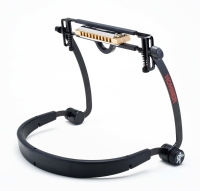 Another approach is to spend more and get the Hohner Flex Rack. As the photo shows, the height, angle and position of the instrument are adjustable. This should keep the harmonica in place, even after the audience has gone…
Another approach is to spend more and get the Hohner Flex Rack. As the photo shows, the height, angle and position of the instrument are adjustable. This should keep the harmonica in place, even after the audience has gone…
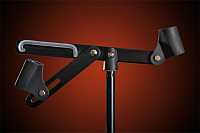 An alternative to strapping a rack around your neck is to use the Harp Hugger. As the picture shows, this attaches to a mic stand, with clips for a mic under the harmonica and another mic for vocals. Very nice. There is also a harp hugger which attaches to a fiddle.
An alternative to strapping a rack around your neck is to use the Harp Hugger. As the picture shows, this attaches to a mic stand, with clips for a mic under the harmonica and another mic for vocals. Very nice. There is also a harp hugger which attaches to a fiddle.
Adjusting the harmonica holder
Put your guitar aside for now. Put the holder around your neck, stand in front of a mirror and insert the harmonica. Now look straight into the mirror and slide the harmonica so the the 4 hole is directly under your nose. The instrument will be slightly off centre, that is how you want it. Most players hit the 4 hole draw note to begin with, this way you can play it without turning your head
If you play mostly blues, then line the harmonica up so the the 3 hole is directly under your nose. Many blues players use the first 6 holes only, this way you can reach them with minimal head turning.
Now push the harmonica firmly against your mouth and play a few notes. Keep your hands on the arms of the holder to maintain the pressure. This harmonica position is not too different from holding the instrument in your hands, you should be getting a good sound (or at least as good a sound as you can make).
However it is hard to move your head away from the instrument when it is this close. making it hard to sing… Now move the harmonica holder a little further away from your mouth. It should be easier to lift your head to sing, but now your head moves forward to engage the holder, and the pressure on the harmonica is not so good. Experiment with these positions until you find the best compromise between maintining pressure on the harmonica and lifting your head away from the holder.
As a harmonica player, I won’t accept compromises in sound, so I keep the holder close to my mouth. I then turn my head sideways to sing, rather than lifting it above the holder (which is hard with the harmonica so close). This means a somewhat side on stance when playing, but I get a better harmonica sound.
Checking your harmonicas
Many guitar players have a couple of harmonicas in their case, with a harmonica holder stashed somewhere else in the bag. If you have had these instruments for a long time they may need replacing. Play a few notes, partiuclarly over the first 6 holes. Play some chords. If they sound sour, then they probably are. It is common for the 4 hole hole draw note to go flat (eventually), similarly the 6 hole blow note. Guitar strings age, so do harmonicas. If yours sound bad, do your audience a favour and buy some new ones.
If you have not bought harmonicas for a long time, then you are in for a nice surprise. Competiton in the marketplace has noticeably improved harmonica quality. There are more choices, as well as some excellent new premium grade instruments. Check some online harmonica retailers if the choices at your local music store are limited.
Time to play…
If possible, tune your guitar with an electronic tuner rather than a note from the harmonica. Harmonica notes vary with breath pressure, also there are subtle variations in harmonica tuning between different brands. An electronic tuner is generally a more reliable reference. Take a C harmonica, put it in the holder and adjust as above.
Now try the two (free) harmonica holder lessons from my Harmonica Academy web site. The first harmonica holder lesson assumes little or no harmonica backgound. If you are more experienced, still try this first lesson. It will get you started with the holder. Click here for the lesson.
The second harmonica holder lesson covers blues, and assumes you can play a two hole draw note as well as bend notes. Click here for the second lesson.
